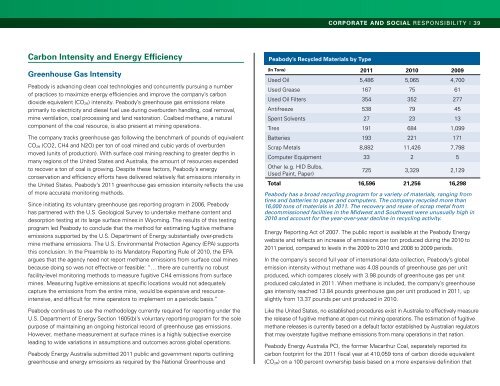Responsibility Report - Peabody Energy
Responsibility Report - Peabody Energy
Responsibility Report - Peabody Energy
Create successful ePaper yourself
Turn your PDF publications into a flip-book with our unique Google optimized e-Paper software.
Corporate and Social responsibility | 39Carbon Intensity and <strong>Energy</strong> EfficiencyGreenhouse Gas Intensity<strong>Peabody</strong> is advancing clean coal technologies and concurrently pursuing a numberof practices to maximize energy efficiencies and improve the company’s carbondioxide equivalent (CO 2e) intensity. <strong>Peabody</strong>’s greenhouse gas emissions relateprimarily to electricity and diesel fuel use during overburden handling, coal removal,mine ventilation, coal processing and land restoration. Coalbed methane, a naturalcomponent of the coal resource, is also present at mining operations.The company tracks greenhouse gas following the benchmark of pounds of equivalentCO 2e (CO2, CH4 and N2O) per ton of coal mined and cubic yards of overburdenmoved (units of production). With surface coal mining reaching to greater depths inmany regions of the United States and Australia, the amount of resources expendedto recover a ton of coal is growing. Despite these factors, <strong>Peabody</strong>’s energyconservation and efficiency efforts have delivered relatively flat emissions intensity inthe United States. <strong>Peabody</strong>’s 2011 greenhouse gas emission intensity reflects the useof more accurate monitoring methods.Since initiating its voluntary greenhouse gas reporting program in 2006, <strong>Peabody</strong>has partnered with the U.S. Geological Survey to undertake methane content anddesorption testing at its large surface mines in Wyoming. The results of this testingprogram led <strong>Peabody</strong> to conclude that the method for estimating fugitive methaneemissions supported by the U.S. Department of <strong>Energy</strong> substantially over-predictsmine methane emissions. The U.S. Environmental Protection Agency (EPA) supportsthis conclusion. In the Preamble to its Mandatory <strong>Report</strong>ing Rule of 2010, the EPAargues that the agency need not report methane emissions from surface coal minesbecause doing so was not effective or feasible: “… there are currently no robustfacility-level monitoring methods to measure fugitive CH4 emissions from surfacemines. Measuring fugitive emissions at specific locations would not adequatelycapture the emissions from the entire mine, would be expensive and resourceintensive,and difficult for mine operators to implement on a periodic basis.”<strong>Peabody</strong> continues to use the methodology currently required for reporting under theU.S. Department of <strong>Energy</strong> Section 1605(b)’s voluntary reporting program for the solepurpose of maintaining an ongoing historical record of greenhouse gas emissions.However, methane measurement at surface mines is a highly subjective exerciseleading to wide variations in assumptions and outcomes across global operations.<strong>Peabody</strong> <strong>Energy</strong> Australia submitted 2011 public and government reports outlininggreenhouse and energy emissions as required by the National Greenhouse and<strong>Peabody</strong>’s Recycled Materials by Type(In Tons) 2011 2010 2009Used Oil 5,486 5,065 4,700Used Grease 167 75 61Used Oil Filters 354 352 277Antifreeze 538 79 45Spent Solvents 27 23 13Tires 191 684 1,099Batteries 193 221 171Scrap Metals 8,882 11,426 7,798Computer Equipment 33 2 5Other (e.g. HID Bulbs,Used Paint, Paper)725 3,329 2,129Total 16,596 21,256 16,298<strong>Peabody</strong> has a broad recycling program for a variety of materials, ranging fromtires and batteries to paper and computers. The company recycled more than16,000 tons of materials in 2011. The recovery and reuse of scrap metal fromdecommissioned facilities in the Midwest and Southwest were unusually high in2010 and account for the year-over-year decline in recycling activity.<strong>Energy</strong> <strong>Report</strong>ing Act of 2007. The public report is available at the <strong>Peabody</strong> <strong>Energy</strong>website and reflects an increase of emissions per ton produced during the 2010 to2011 period, compared to levels in the 2009 to 2010 and 2008 to 2009 periods.In the company’s second full year of international data collection, <strong>Peabody</strong>’s globalemission intensity without methane was 4.08 pounds of greenhouse gas per unitproduced, which compares closely with 3.98 pounds of greenhouse gas per unitproduced calculated in 2011. When methane is included, the company’s greenhousegas intensity reached 13.84 pounds greenhouse gas per unit produced in 2011, upslightly from 13.37 pounds per unit produced in 2010.Like the United States, no established procedures exist in Australia to effectively measurethe release of fugitive methane at open-cut mining operations. The estimation of fugitivemethane releases is currently based on a default factor established by Australian regulatorsthat may overstate fugitive methane emissions from many operations in that nation.<strong>Peabody</strong> <strong>Energy</strong> Australia PCI, the former Macarthur Coal, separately reported itscarbon footprint for the 2011 fiscal year at 410,059 tons of carbon dioxide equivalent(CO 2e) on a 100 percent ownership basis based on a more expansive definition that

















